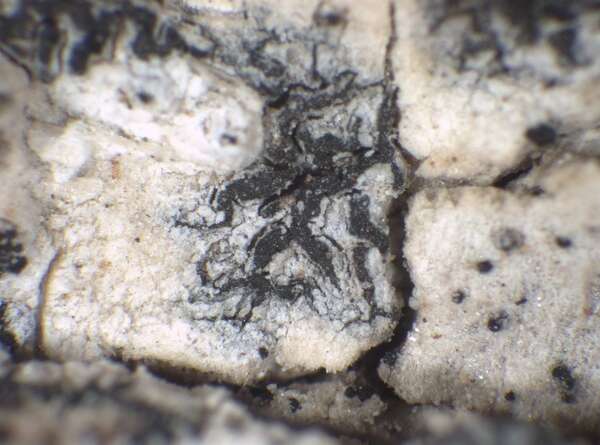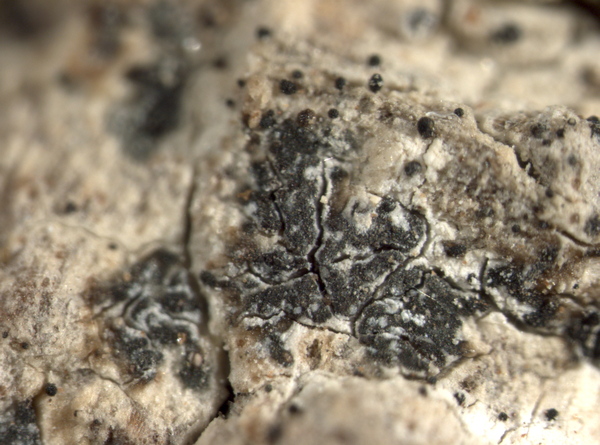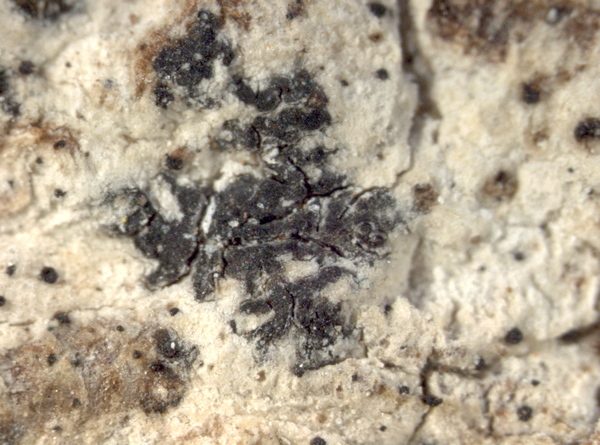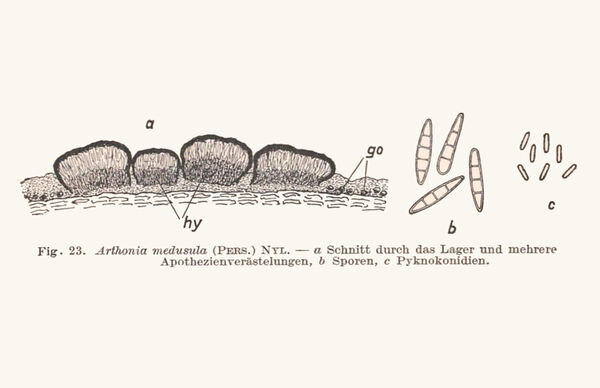Arthonia medusula (Pers.) Nyl.
Mém. Soc. Imp. Sc. Nat. Cherbourg, 5: 132, 1857. Basionym: Opegrapha medusula Pers. - Ann. Wetter. Gesellsch. Ges. Naturk., 2: 15, 1810.
Synonyms:
Distribution: N - Ven. C - Laz.
Description: Thallus crustose, episubstratic, thin, whitish to yellowish white. Apothecia arthonioid, lirelliform, brown-black, semi-immersed in the thallus, 0.5-2 mm long, branched to stellate, with a mostly flat, grey-pruinose or rarely epruinose disc. Proper exciple poorly evident; epithecium blue-black, rarely dark olive-brown, K+ greenish; hymenium colourless to pale brown, 50-75 µm high, I+ blue; hypothecium colourless to pale yellowish. Asci 8-spored, broadly clavate, semi-fissitunicate, with a large apical dome and a distinct ocular chamber, Arthonia-type. Ascospores (2-)3(-4) septate, hyaline, more or less fusiform, 9-18 x 2-3 µm, the apical cell not enlarged. Pycnidia common, black but often white-pruinose, slightly emerging from thallus. Conidia bacilliform, 5-6 x 1-1.2 µm. Photobiont trentepohlioid. Spot tests: thallus K- or K+ yellowish, C-, KC-, P-. Chemistry: unidentified substances in thallus.Note: a mild-temperate, suboceanic lichen found on old oaks, in dry parts of the trunks seldom wetted by rain, in parklands and open woodlands. The record from Veneto (see Nimis 1993: 80) requires confirmation. It is included in the Italian red list of epiphytic lichens as “Critically Endangered” (Nascimbene & al. 2013c).
Growth form: Crustose
Substrata: bark
Photobiont: Trentepohlia
Reproductive strategy: mainly sexual
Most common in areas with a humid-warm climate (e.g. most of Tyrrenian Italy)
In underhangs rarely wetted by rain
Commonnes-rarity: (info)
Alpine belt: absent
Subalpine belt: absent
Oromediterranean belt: absent
Montane belt: absent
Submediterranean belt: extremely rare
Padanian area: absent
Humid submediterranean belt: extremely rare
Humid mediterranean belt: absent
Dry mediterranean belt: absent

Predictive model
Herbarium samples
Growth form: Crustose
Substrata: bark
Photobiont: Trentepohlia
Reproductive strategy: mainly sexual
Most common in areas with a humid-warm climate (e.g. most of Tyrrenian Italy)
In underhangs rarely wetted by rain
Commonnes-rarity: (info)
Alpine belt: absent
Subalpine belt: absent
Oromediterranean belt: absent
Montane belt: absent
Submediterranean belt: extremely rare
Padanian area: absent
Humid submediterranean belt: extremely rare
Humid mediterranean belt: absent
Dry mediterranean belt: absent

Predictive model
| Herbarium samples |
 Index Fungorum
Index Fungorum
 GBIF
GBIF






